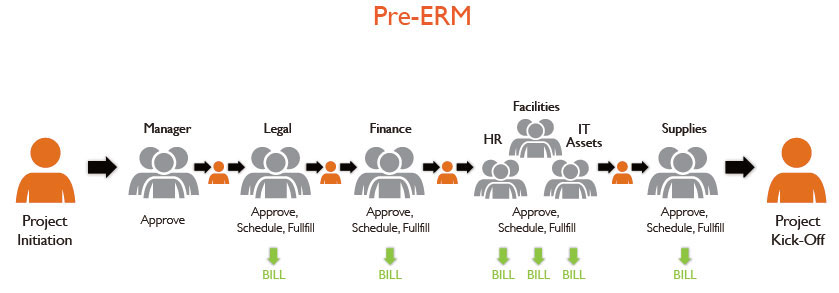What’s New at Kinetic: Building Smart in 2026
At Kinetic, we believe the future of Business Process Management isn’t bigger—it’s smarter.
In most large enterprises today, shared services are delivered through functional silos: IT provisions equipment and software access, HR manages PTO requests and new-hire processes, Facilities...

In most large enterprises today, shared services are delivered through functional silos: IT provisions equipment and software access, HR manages PTO requests and new-hire processes, Facilities manages space planning and allocation, etc.
If you need one of those services, you work with that group’s systems. If you need multiple services—for example, to reserve workspace, hire staff, and install phones and computers for a project—you’ll likely have to work with multiple systems, obtain multiple approvals, manually schedule tasks, and juggle all of the pieces to coordinate activities with target dates.
It all makes complete sense from the standpoint of each individual department. Internally, they may even have optimized certain standard processes (e.g., ordering and it provisioning a laptop). Each department is well-versed in and very efficient at using its own software.
The problem is, these processes often make no sense from the standpoint of the (external or internal) customer. How do you determine which group delivers the service you need? (It’s not always obvious.) Why do you have to learn and use different systems to make simple requests? Manually ask for approvals (and create reminders to follow up if an approval isn’t obtained promptly)? Who decided that the “standard” delivery time for a new laptop was X number of days? And for requests that cross departmental lines—why do you have to enter the same information into multiple applications or online forms?
In actuality, those “optimized” intradepartmental tasks often entail processes that waste time, cost more than necessary, frustrate customers, and lead to error-prone duplicate manual data entry. The customer is forced to consciously and actively manage the process, when all they really want is to place a request and receive a service.
Enterprise request management (ERM) is a better approach to managing service requests and fulfillment. In the ERM model, customers can request any type of enterprise shared service (including, most importantly, services that span different functional groups) from a single, intuitive web-based and mobile-friendly portal interface. One front end to use regardless of the type of request, with little to no training required.
The portal routes the request to an automated task management “backbone” application that can automatically manage approvals, scheduling, and fulfillment by securely communicating with and between existing departmental software systems. No one on the service delivery side has to give up the software they are accustomed to or make major investments in implementing and learning new systems.
Information is entered once, validated, then shared as needed between federated data sources. This saves time, reduces customer frustration, and virtually eliminates errors, enabling consistent first-time fulfillment. Elapsed time, costing, user satisfaction and other reporting elements are automatically logged throughout the process.
This approach also provides complete visibility into the status of a request at any time (similar to online package tracking), so the customer never has to call or send an email to find out “where things are at.” Instead of asking “how long does it take to get a new laptop?” managers can ask “how long should it take?”
The end result is a delighted customer, who now has a single intuitive interface for requesting services and checking on delivery status, and who gets services delivered promptly and accurately and with less effort. The enterprise saves time, reduces the cost of service delivery, and eliminates data errors and rework through automation. Visibility into processes supports continuous process improvement.
To learn more about the ERM approach, download the whitepaper Enterprise Request Management: An Overview.

At Kinetic, we believe the future of Business Process Management isn’t bigger—it’s smarter.

IT support automation uses software workflows, rule engines, AI/ML, and integrations to automate...

Business process reimagined is the strategic renewal of how work gets done by combining modern digital...